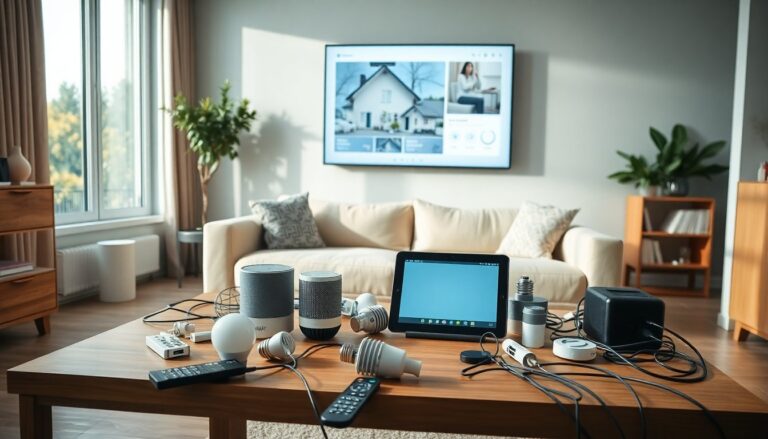Argomenti trattati
For a considerable time, my smart home system resembled a chaotic web rather than a model of convenience. Despite my enthusiasm for the latest gadgets, my efforts to create a seamless environment resulted in a confusing assortment of devices that complicated my daily life.
My experience with Alexa, Google Home, and the Apple Home app became a frustrating ordeal, marked by unresponsive devices, overlapping functionalities, and automations that failed to deliver. The Hue Bridge struggled under this disarray, and attempts to integrate platforms like SmartThings and Homey only added to my frustration. It became clear that a significant overhaul was necessary. Here’s how I reset my smart home and restored balance to my living space.
Recognizing the chaos
Many enthusiasts may find themselves in a similar predicament. Initially, I added devices to my Alexa ecosystem because it was straightforward. However, as the market for smart home products grew, I lost control over managing my devices. My once user-friendly interface turned into a confusing mess.
While Alexa has improved with features like Zigbee integration and support for Thread, it still lacks the depth required for complex setups. Relying on an assistant primarily designed for simple tasks led to challenges in managing a myriad of interconnected devices.
Transitioning to a new platform
As I explored alternatives, I began migrating some of my devices to Apple’s HomeKit. This ecosystem offers better compatibility for users entrenched in the iOS environment. However, even HomeKit did not quite measure up to the capabilities of professional installations such as those from Crestron or Control4. I needed a robust, user-friendly system that my family could easily navigate without sacrificing functionality.
Despite my desire to move away from Alexa, it remained integral to our household. We relied heavily on our Amazon Echo Show devices for voice commands and intercom features, making it challenging to abandon the platform entirely. However, maintaining the system required constant monitoring and troubleshooting, particularly with issues like devices going offline without warning or frustrating duplication of devices.
Finding a sustainable solution
The core problem lay in the cloud-based nature of my setup. Each time I added a new device, Alexa often created multiple listings for the same product, leading to a cluttered interface. This was particularly problematic with products like Philips Hue bulbs, where I ended up with numerous variants appearing in the app. Managing these duplicates was a nightmare, as each command would trigger a response indicating that multiple devices existed with the same name.
The situation worsened when Amazon discontinued the Alexa web portal, which had allowed for mass device management. The only way to clear out outdated devices was through painstaking individual deletions, often requiring a factory reset of my Echo speakers. This was no longer sustainable.
Embracing local control with Home Assistant
What I truly needed was a switch to a system that operated locally, free from the cloud’s constraints. The advent of Home Assistant marked a significant turning point in my smart home journey. This platform has evolved from a complex DIY project to a more accessible option for everyday users.
With the Home Assistant Green hub, setting up my smart home became a plug-and-play experience. The platform automatically detected many connected devices, and the extensive catalog of Integrations allowed me to customize my setup with ease. Unlike other systems that could be more restrictive, Home Assistant allows a mix of communication protocols, enabling seamless integration across devices.
Achieving automation and control
My experience with Alexa, Google Home, and the Apple Home app became a frustrating ordeal, marked by unresponsive devices, overlapping functionalities, and automations that failed to deliver. The Hue Bridge struggled under this disarray, and attempts to integrate platforms like SmartThings and Homey only added to my frustration. It became clear that a significant overhaul was necessary. Here’s how I reset my smart home and restored balance to my living space.0
My experience with Alexa, Google Home, and the Apple Home app became a frustrating ordeal, marked by unresponsive devices, overlapping functionalities, and automations that failed to deliver. The Hue Bridge struggled under this disarray, and attempts to integrate platforms like SmartThings and Homey only added to my frustration. It became clear that a significant overhaul was necessary. Here’s how I reset my smart home and restored balance to my living space.1
My experience with Alexa, Google Home, and the Apple Home app became a frustrating ordeal, marked by unresponsive devices, overlapping functionalities, and automations that failed to deliver. The Hue Bridge struggled under this disarray, and attempts to integrate platforms like SmartThings and Homey only added to my frustration. It became clear that a significant overhaul was necessary. Here’s how I reset my smart home and restored balance to my living space.2

